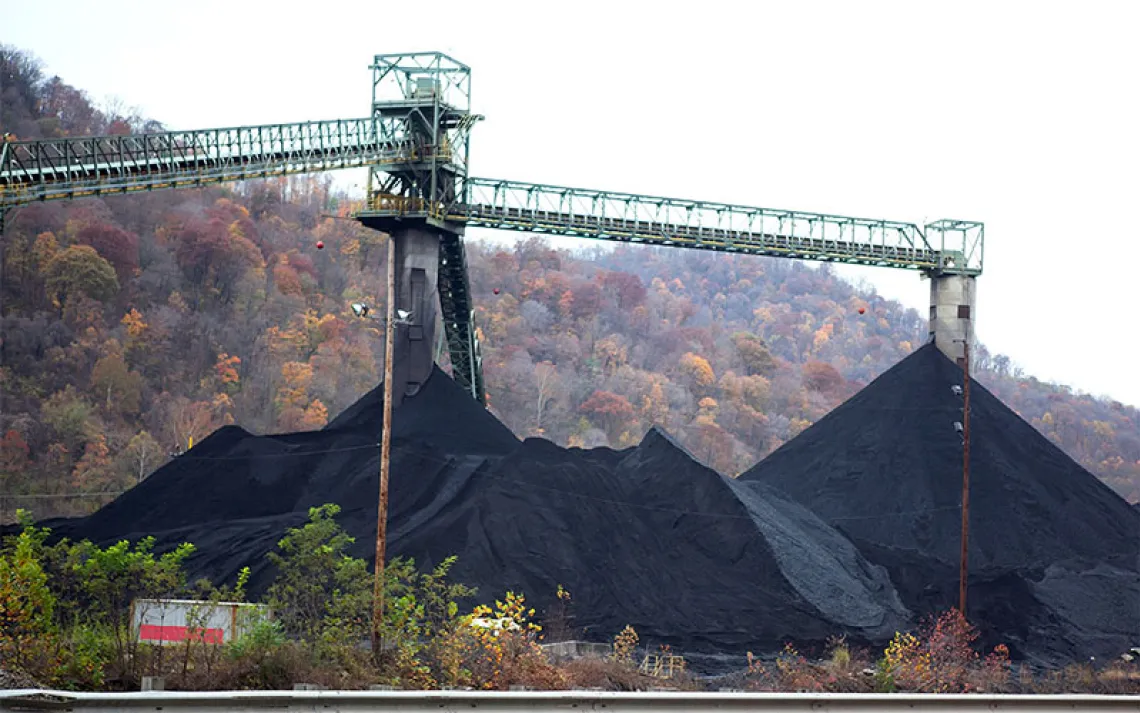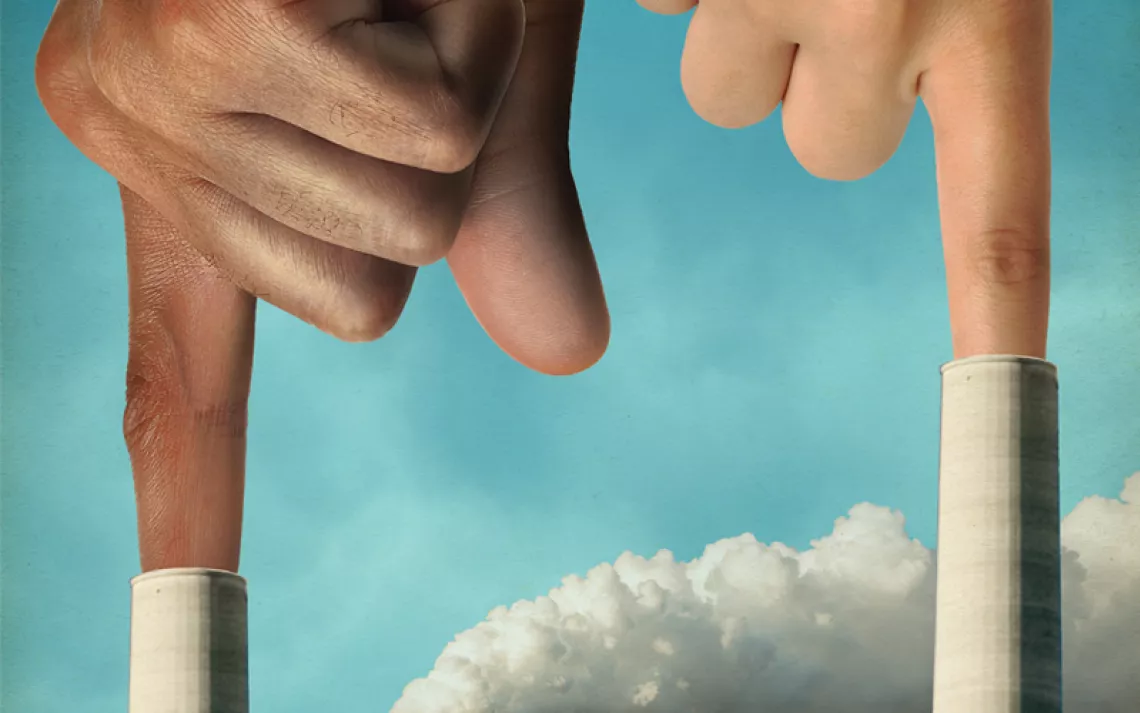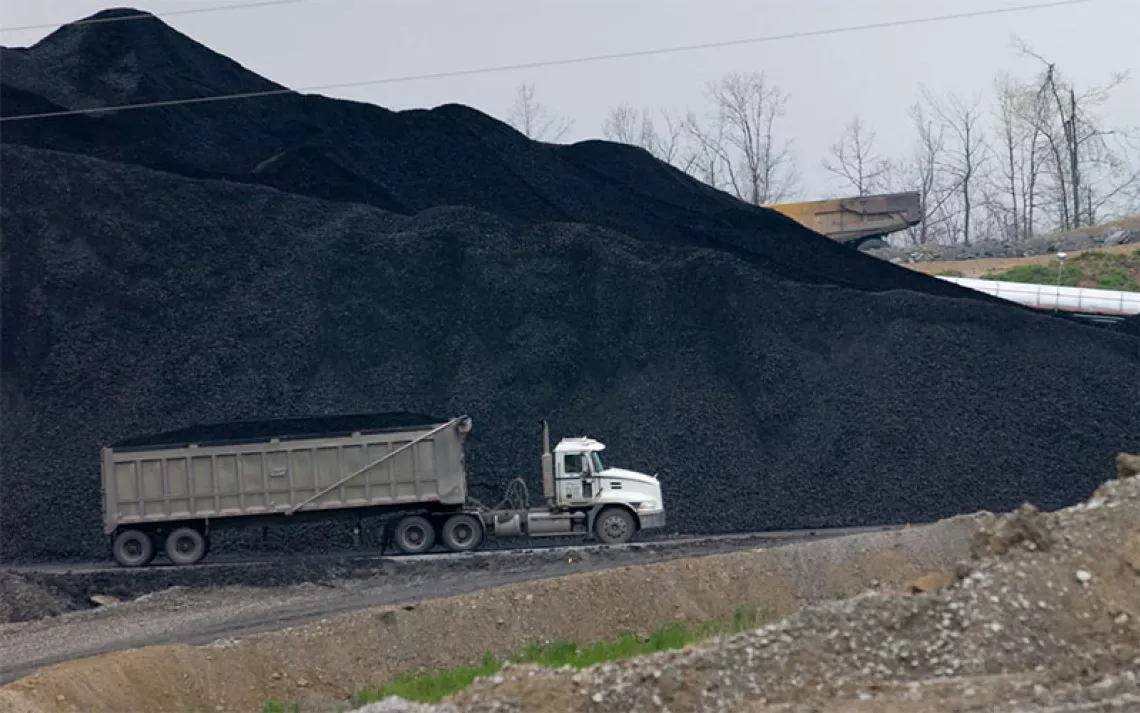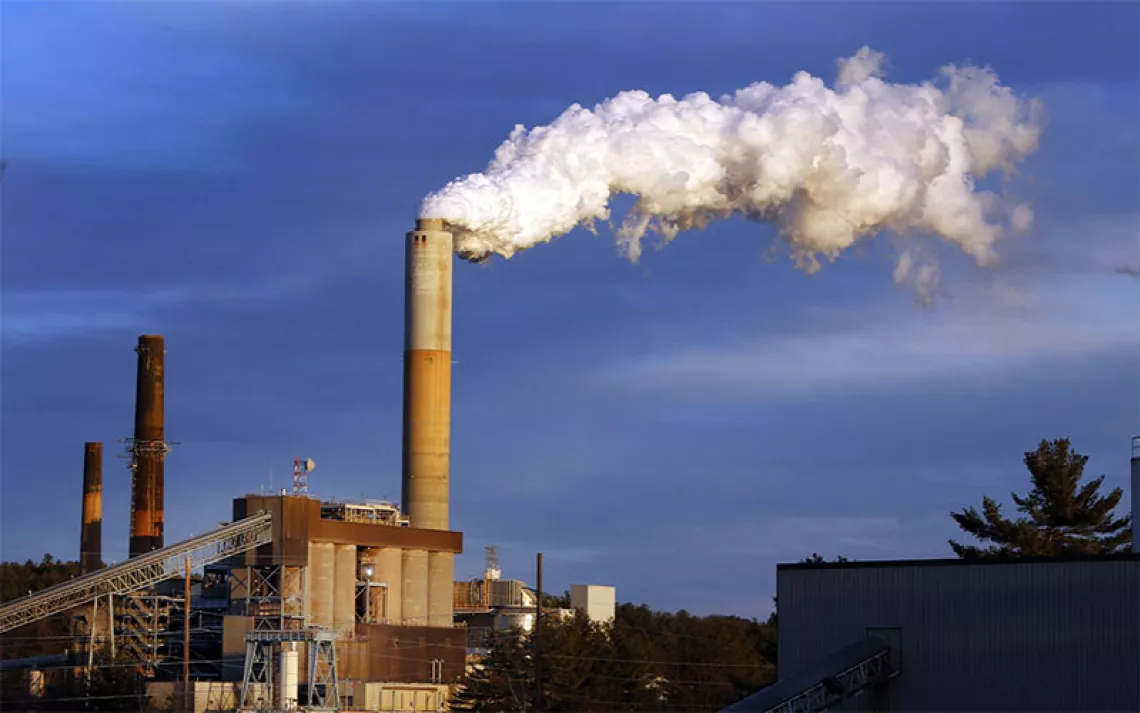Digging a Hole for China
Mining companies want to export U.S. coal to China. But first they have to go through Longview.

Each bite of this bucket at Wyoming's Black Thunder mine holds 170 cubic yards of coal. | Photo by Melissa Farlow
Remember last spring? There was sunshine and Frisbees and chilled drinks, and that hopey-changey thing was still alive. Climate legislation creeping through Congress had polluters quaking, Sierra Club activists and lawyers had scotched 149 proposed coal-fired power plants, and demand for coal was flagging nationwide.
Five days after the November midterm election, though, things don't look so rosy. That carbon cap-and-trade bill is shivering in an alley somewhere in Washington, D.C., and half the newly elected Republican members of Congress don't believe that humans contribute to global warming.
On this rainy night, the front line in the fight against climate catastrophe is a meeting room in Longview, Washington, an industrial town on the Columbia River. Seven people are sitting around trying to figure out how to prevent millions of tons of U.S. coal from being shipped from the strip mines of the Powder River Basin, in southeast Montana and northwest Wyoming, across the Pacific to feed the insatiable coal plants of China.

Wrecks like this one near Baltimore, Ohio, are sometimes caused by a buildup of coal dust on the tracks. | Photo by Reuters
Despite all its wind turbines and solar panels, China is building new coal plants like there's no tomorrow. China now burns more than 3 billion tons of coal a year, half the total consumed worldwide; between 2007 and 2010, it increased the gigawatts it gets from coal by 28 percent. U.S. coal honchos are saying that if no one wants it here, they'll be happy to lug this black rock halfway around the world and sell it in Asia.
Doing so, however, would largely undermine the gains the U.S. environmental community has achieved thus far. After all, coal releases the same amount of greenhouse gas whether it's burned in Asia or Illinois. That's why this small group of activists is scheming to keep it buried beneath the Powder River Basin.
Dan Serres, of Columbia Riverkeeper, explains that Australia-based Ambre Energy, through subsidiary Millennium Bulk Logistics, wants to export Powder River Basin coal via a new shipping terminal here in Longview. He shows a picture of the proposed site as it stands now, an industrial complex with a long proboscis of a pier sticking out into the river. Starting at a relatively modest 5 million tons a year, Ambre could ramp up to 30 million tons as the infrastructure catches up.

Graphic by Michael Newhouse
The Powder River Basin has a lot of coal to ship. The region accounts for nearly 40 percent of all coal mined in the United States, outproducing Appalachia. Its Black Thunder Mine alone brings more coal to market than all states except Wyoming, West Virginia, and Kentucky. According to the U.S. Geological Survey, the Gillette field, a single division within the basin, has about 77 billion tons of recoverable coal. It would take the United States almost a century to burn all that coal—but China could eat through it in 25 years or less.
(Despite these gaudy numbers, the federal government still does not classify the Powder River Basin as a "coal producing region." If it did, new mines would receive more environmental scrutiny, and competitive bidding between mining companies would be required.)
Ambre isn't alone in staking out export facilities, but it's the first to apply for a permit. Peabody Energy says it's looking for a big new export facility, and Cloud Peak Energy CEO Colin Marshall has said that a West Coast terminal is "a question of when rather than if." So the decision on Ambre's permit application, to the Cowlitz County Commission, could set a precedent for many future proposals.

Sign up to receive Sierra News & Views
Get articles like this one sent directly to your inbox weekly.
With this action you affirm you want to receive Sierra Club communications and may vote on policy designated by the Sierra Club Board.
Ambre wants to build its terminal on the site of a facility currently owned by aluminum company Alcoa and operated by Chinook Ventures. The latter built a conveyor belt on the pier, which it operated without a permit; last February, that conveyor spilled petroleum coke into the river, forming a mile-long slick. The Washington Department of Ecology fined the company $40,000, but had to just add it to the tab because Chinook hadn't finished paying a $150,000 fine assessed 11 months earlier for a litany of environmental violations.

Anti-coal activists Dan Serres and Gayle Kiser are fighting to keep China-bound coal freighters off the Columbia River. | Photo by Steve Dykes
Which is all to say that a major international coal company, flush with cash and offering to fix up a contaminated industrial site, looks pretty good to the powers that be in Cowlitz County. "They see Ambre as the knights on white horses coming in to clean up the mess," says Gayle Kiser, another local opponent. Ambre is hoping to begin construction by mid-December, before the eulachon—a newly threatened variety of smelt—shows up to spawn, and the threatened Steller sea lions show up to eat them, and the terminal is delayed for another year.
At the meeting, Serres, Kiser, and company are, naturally, discussing ways to delay the terminal for another year. "What laws? What do we have to prevent this?" Sierra Club volunteer Grant Sawyer says. "Is there any point in appealing to their sense of decency?"
It is decided that there is probably not.
A more likely tack is to highlight the fact that the trains transporting all that coal to port will shed their cargo like old Christmas trees shed needles. Burlington Northern Santa Fe railway estimates that each car loses a minimum of 500 pounds of coal for every 500 miles traveled. With two trains a day to Longview from the Powder River Basin, 25,000 tons of coal would be blown off the cars each year—about the same as dumping two entire trainloads on the ground.
Serres argues that the activists' best bet at the next hearing is to push for further environmental review. It might not end the port project, but it would at least push back its timeline. Kiser tells the group that her sources in the Cowlitz County planning department say that Ambre is intimating that if it can't get its permit quickly, it will just walk away. So delaying this one permit could derail the whole project.
* * *
Shipping coal to China is such a mammoth task that future historians may regard it as one of those crazy, impractical feats of engineering, like Stonehenge, the pyramids, or the shelf life of Twinkies. But Big Coal is doing it.
"You've got to understand, this is the focus of the coal industry right now," says Mark Kresowick, northeast regional director for the Sierra Club's Beyond Coal campaign. "They recognize that U.S. coal consumption is declining. Their only growth potential is in the export market."
Thirteen hundred rail miles from the nearest deepwater port, the Powder River Basin is the mother of all export projects. Its coal is cheap to mine because the seams are near the surface—slough off the top layer of dirt and there it is in broad daylight, no headlamps or tunnels necessary. It's also low-Btu, meaning you have to burn more of it to get the same amount of heat. Stripmining like this is mostly handled by machines the size of houses that scoop up chunks of ground as if from God's own sandbox and load it into hoppers. The mechanization and vast scale mean that coal companies don't need many employees, so even after paying $2,080 per 117-ton railcar to transport it to a western port and half a million dollars for a freighter to ship it to China, the price is still competitive.
Here's how this round-the-world supply chain became practical: In 2008 and 2009, the financial crisis and ensuing industrial downturn slowed coal demand across the globe, substantially lowering the price of coal. A Stanford University report shows that in late 2009, Indonesian and Russian coal was cheaper than China's by as much as $40 per ton. The recession also depressed freight prices: Chartering a boat to haul 70,000 tons of coal might have cost $50,000 a day in 2007; now it's more like $12,000. At prices like that, coal from Greenland could compete in the Chinese market.
Remember that 60-mile traffic jam outside Beijing that lasted from mid-August until September 2010? Infrastructure issues are crippling transportation within China. With the population centers (and coal plants) largely in the southeast and most of the coal in the northwest, there just isn't enough space on the train tracks and roads to transport it directly. Instead, it's first sent east to ports in northeast China, then loaded onto boats and shipped down the coast—a voyage only slightly shorter than that from Indonesia or Australia. Imports still represent a small piece of the pie—China brings in about 150 million tons of coal a year but burns more than 3 billion—and demand for foreign coal is likely to grow.
Last November the journal Nature reviewed Chinese coal surveys and found them to be unreliable. China, once thought to have 62 years of reserves, may actually have less than 20, when you factor in increasing demand and unrecoverable coal seams. And so the country is looking abroad. Australia has developed a new complex of mines—called China First—for the sole purpose of feeding its need. The resulting $68-billion deal is Australia's largest-ever export contract.
Stateside, U.S. exports have already begun. Consol Energy says that Chinese demand has single-handedly created a new market for shippers at its CNX terminal in Baltimore. In the first half of 2010, the United States sent 2.9 million tons of coal to China. In all of 2009, we sent 2,714 tons.
China is not the only overseas customer for U.S. coal. Anticipating the power demands of its own upwardly mobile billion-person population, India is on the hunt for new supplies, and Korea and Thailand are also likely markets. Peabody Energy, the company that puts the "Big" in "Big Coal," is positioning itself to export to these and other new markets—in the interest of eradicating what it calls "energy poverty."
"The more electricity societies use, the longer people live in those societies," said Peabody executive Fred Palmer during a debate at Washington University in St. Louis in April. "We're gonna have a lot of poverty to be eradicating, because there are a lot of us and there's more coming."
* * *
Back in Longview, at the public hearing, I find a seat next to two crunchy-looking students from Evergreen State College. There are two TV cameras on tripods and a New York Times photographer testing his flash. County commissioners Axel Swanson and George Raiter start the meeting. First, the three commissioners vote on whether the time has come to put the county's beloved Chevy Lumina up for auction after 30 years of service. They agree it has.
Then Tom McGuire, the county planner who reviewed Ambre's application, gives a short slide show on the proposal, outlines the creosote pillars to be replaced with concrete, the rail crossings, the greenhouse gases, and the coal dust, from both trains and the storage pile. When he's done, he takes a long breath. "Staff recommends approval," he says.
This is technically just a county shoreline-permit hearing, a hoop Ambre needs to jump through to make improvements to the pier before it can be used to load ships. But with the media here and an open forum for public comment, the shoreline issue is a sidelight. Most of the packed room is opposed to the terminal because of the contribution it will make to global warming. When the floor opens for comments, most either take a hard line against all coal everywhere or argue for more environmental analysis. Commissioner Raiter makes his opinion known early: He doesn't think we should ship coal to China, either; he thinks we should burn it here instead.
During a break, I talk with Stephen Horn, a local resident who's in favor of the project. Someone is going to ship the coal to China, he reasons, so why not get the taxes from it in Longview? Which brings up an interesting point: If this terminal is stopped, there are ports up and down the Columbia that could handle the business. If all those are stopped, China and India will likely buy more coal from Australia, Indonesia, and South Africa.
So what are we doing here?
It's a thought that Millennium CEO Joe Cannon takes up when the company's press handler practically shoves us together after the hearing. "This is not going to have an effect on increased greenhouse-gas emissions; it's just not," he says. Cannon is a lawyer and former editor of the Utah Deseret News in his fourth week on the job at Millennium. He's jolly and prone to rambling and feels the need to justify the greenhouse gases when we talk.
"China's going to burn coal. It doesn't matter if it comes from the Powder River Basin or wherever it comes from, they're going to burn coal. This isn't going to affect the actual greenhouse-gas emissions in China. If it weren't for sale, they'd just buy Russian coal."
* * *
Despite the fact that U.S. coal demand is tapering off, most of the coal coming out of the Powder River Basin is already spoken for domestically. Coal companies would need to open new mines to fill their China-bound vessels, giving coal opponents a couple of footholds. The Sierra Club is currently tracking 12 new leases in the area—holding 5.8 billion tons of coal—making sure that all environmental policies are followed and filing lawsuits if they are not.
"In challenging Western strip mines, this is a new ballgame," says Mike Scott, associate regional representative for the Beyond Coal campaign in Montana. "We don't know what's going to work."
One novel approach could make disagreements about port facilities moot. The Sierra Club, Defenders of Wildlife, and WildEarth Guardians are suing to force the Bureau of Land Management to account for CO2 emissions when reviewing lease applications and to consider the environmental impact of those emissions.
In Longview, however, these arguments have yet to gain traction. It's a cold, snowy morning a week after the public hearing, and I'm awaiting the shoreline-permit decision. Many of the usual suspects at these hearings are stuck at the top of steep, icy driveways and can't get here.
There are no surprises, no dramatic interventions or moving speeches about climate catastrophe. The three commissioners vote aye (Raiter's preference for burning the coal at home notwithstanding), the meeting continues, and the front line in the global-warming fight shifts elsewhere.
After all, when you have a 7,000-mile-supply chain, it only takes one successful objection for the whole thing to fall through. There will be arguments from Billings to Guangzhou over everything from air quality to groundwater contamination to coal-train traffic jams. Nor is this the only coal-trade route under fire. Australian environmentalists temporarily shut down coal exports with protests last September. While I was talking to Cannon in Longview, 800 people in the Philippines arranged themselves in a clearing to spell out "No to Coal." A few days earlier, just up Interstate 5, the port of Tacoma, Washington, nixed a proposed coal terminal, citing public outcry. And in December, the Sierra Club and other environmental groups would appeal the Longview decision in part because of its failure to consider the effects of increased coal mining and burning. The appeal would cause Ambre to miss this winter's con-struction window.
"You have to stop it where you are," says Joanna Levy, one of the Evergreen students at the Longview hearing. "It's up to everyone, everywhere."
This article was funded by the Sierra Club's Beyond Coal campaign.
 The Magazine of The Sierra Club
The Magazine of The Sierra Club



